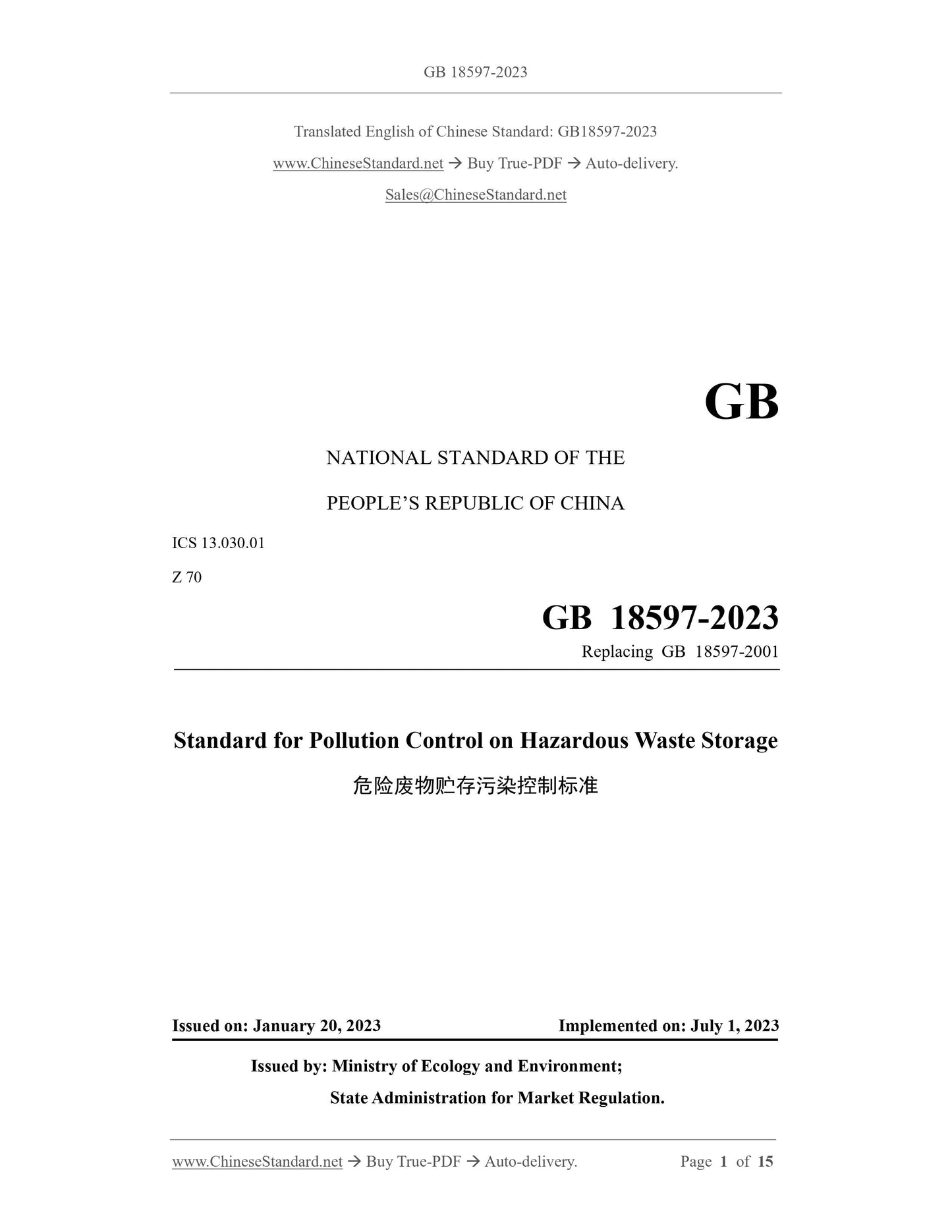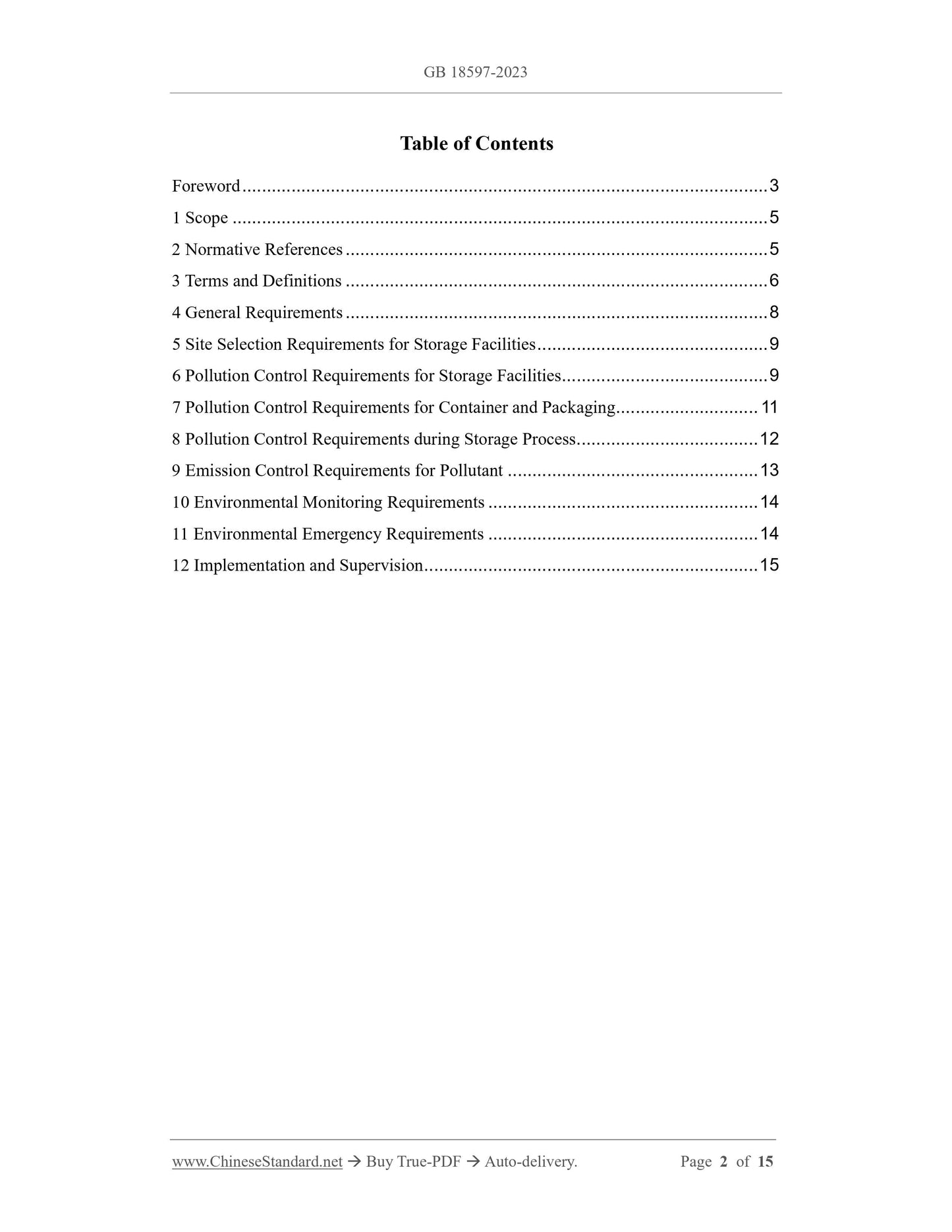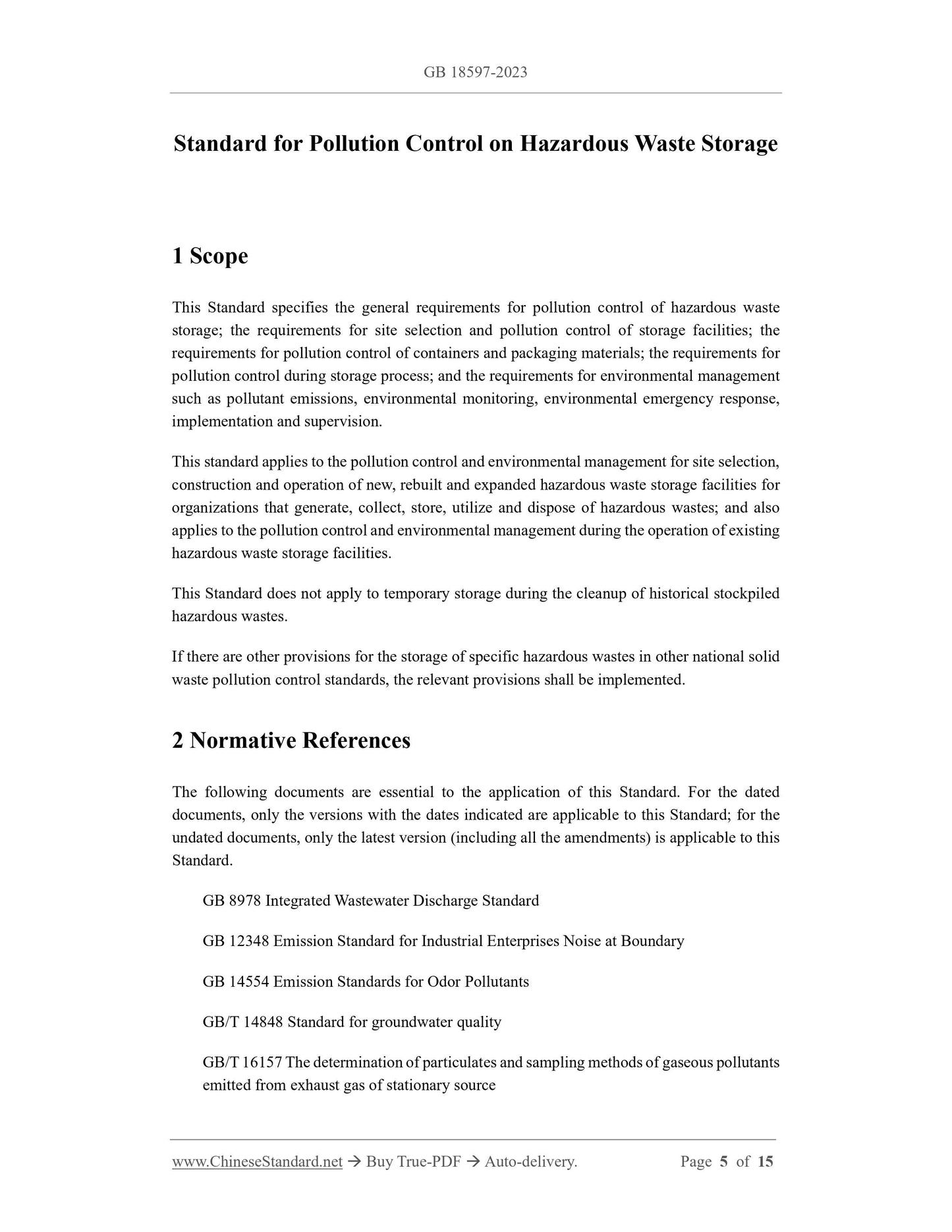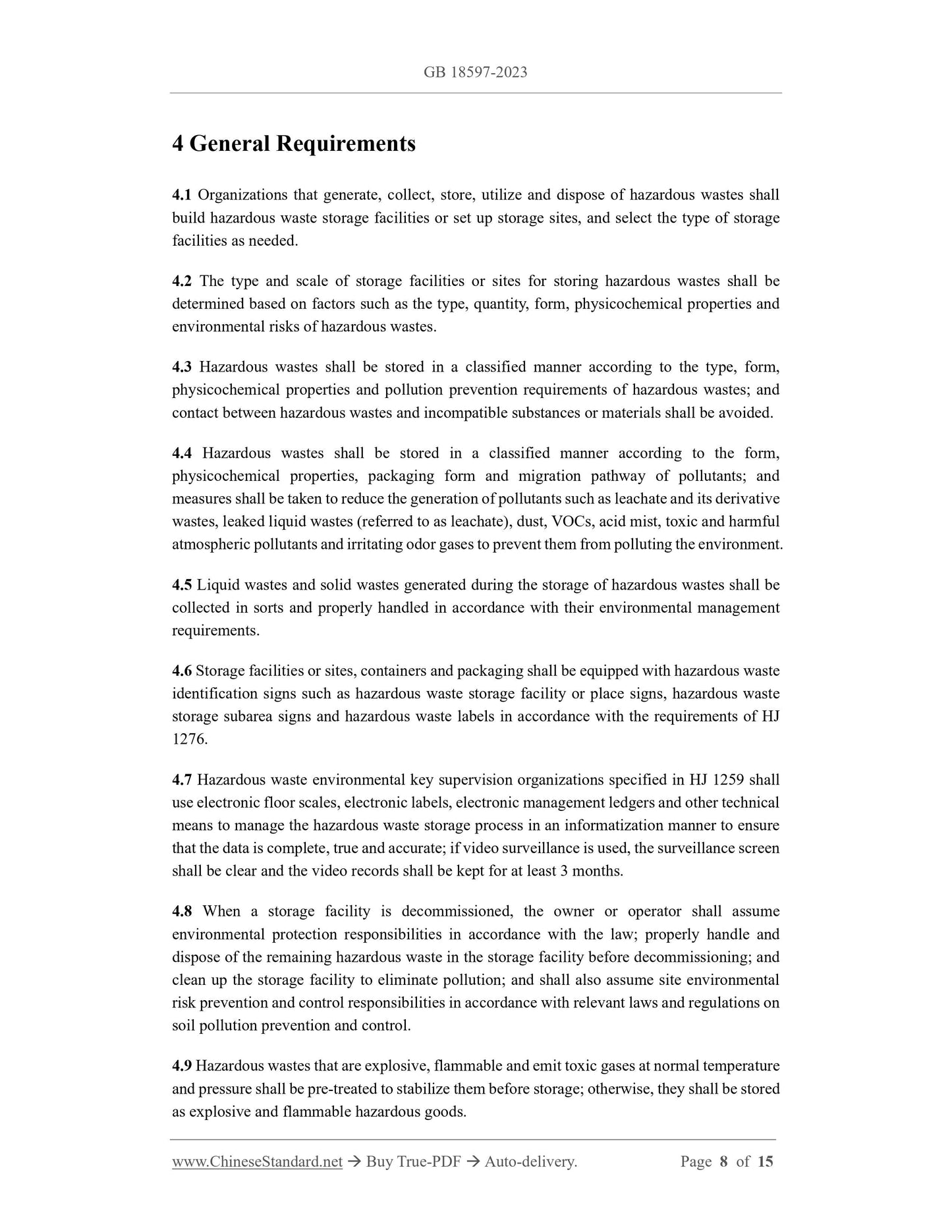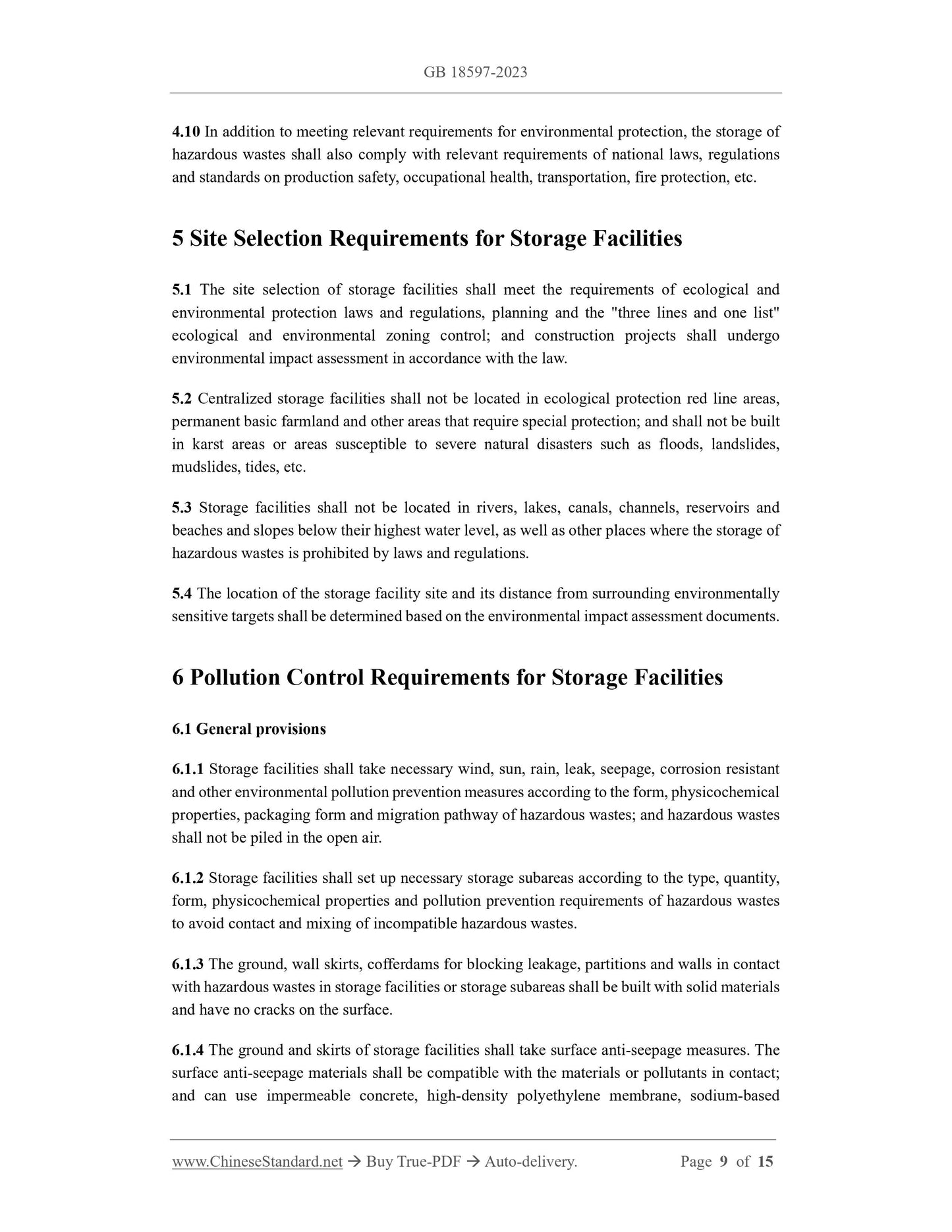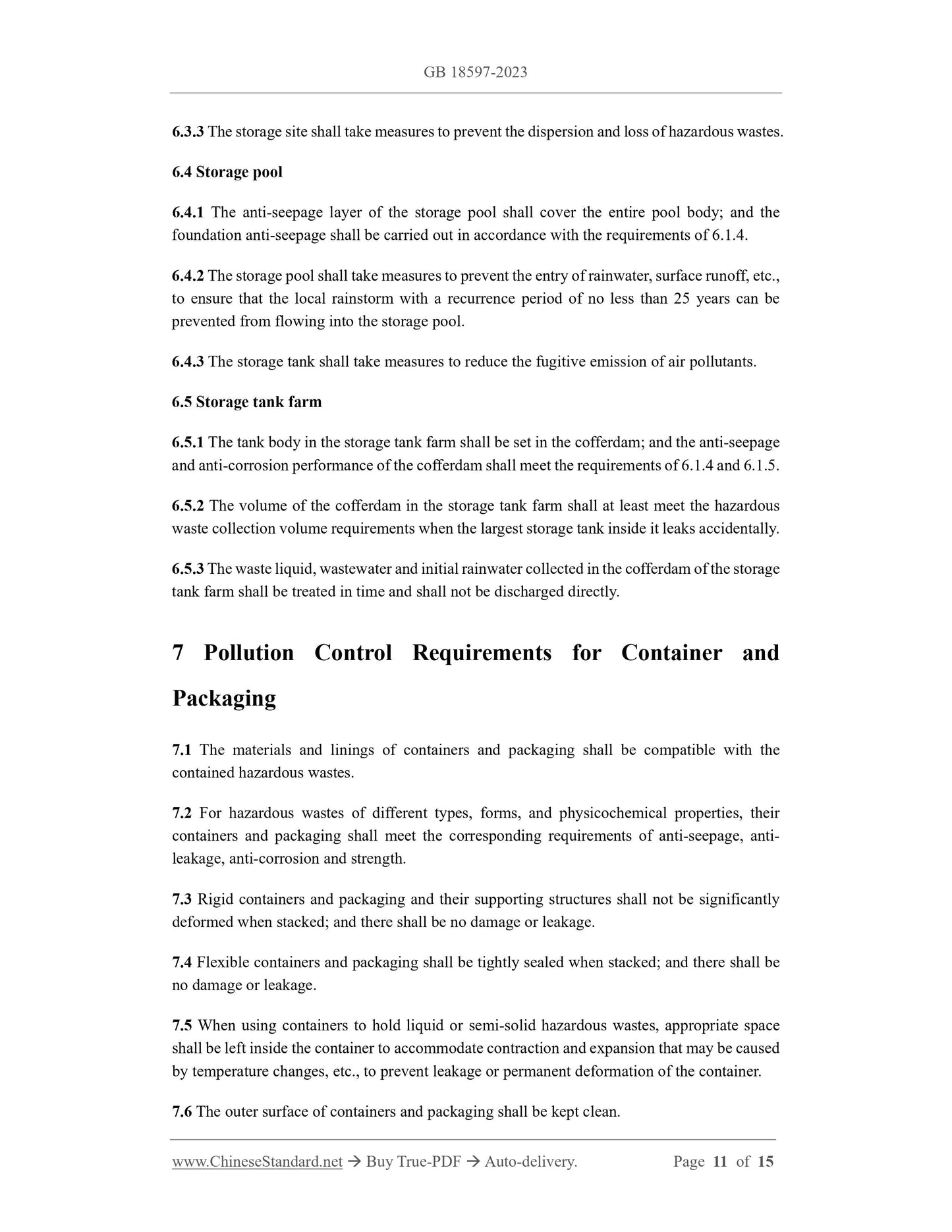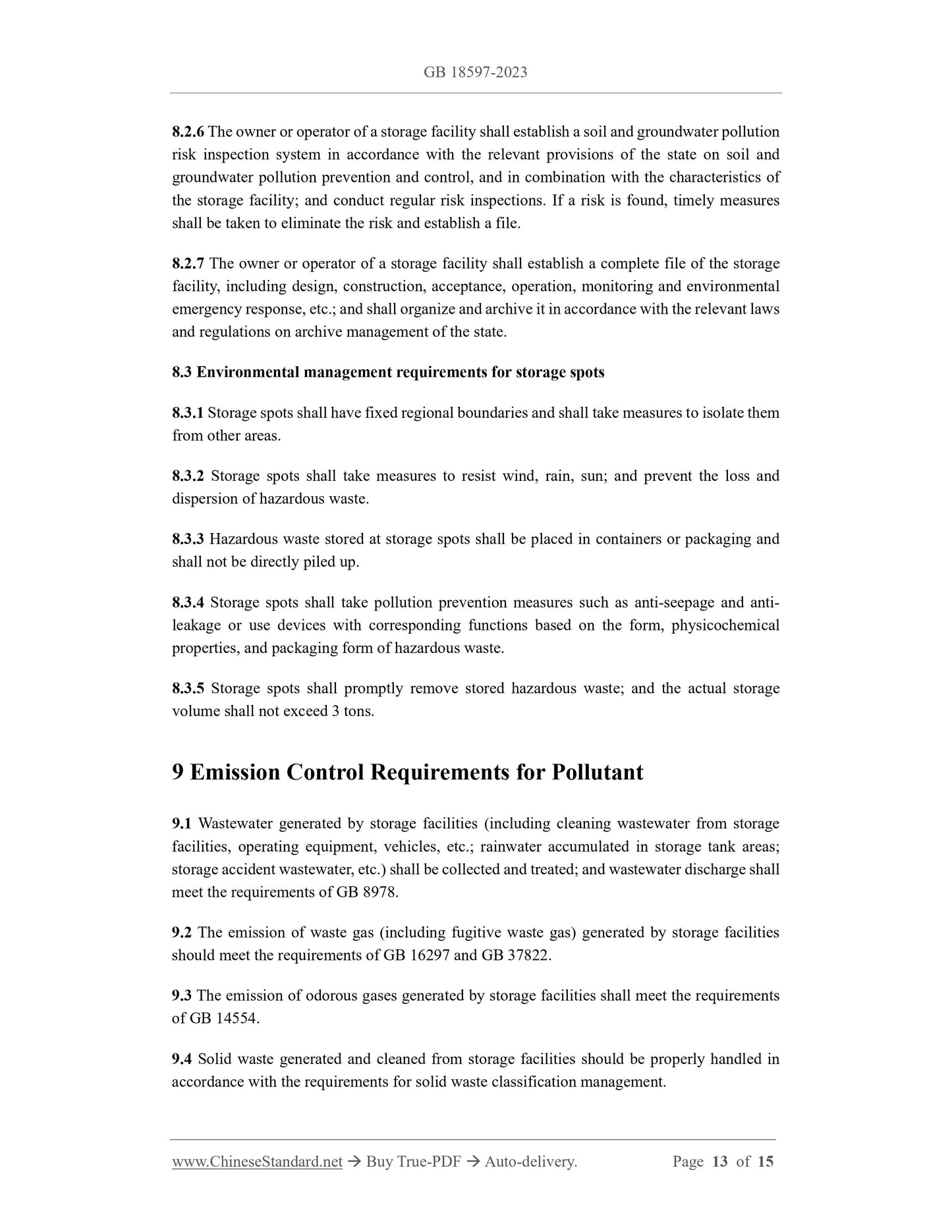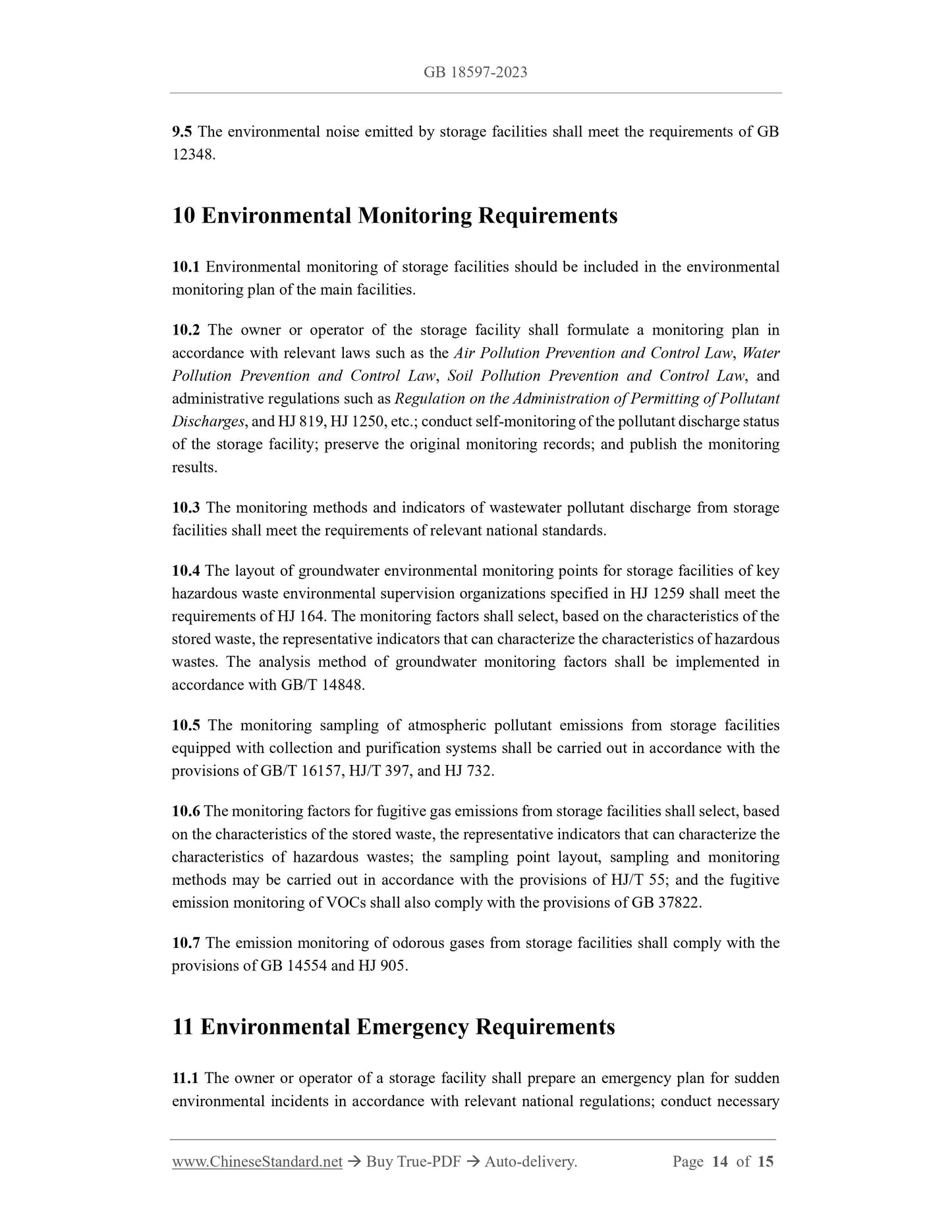1
/
of
8
Sales@ChineseStandard.net (Field Test Asia Pte. Ltd.)
GB 18597-2023 English PDF (GB18597-2023)
GB 18597-2023 English PDF (GB18597-2023)
Regular price
$155.00 USD
Regular price
Sale price
$155.00 USD
Unit price
/
per
Shipping calculated at checkout.
Couldn't load pickup availability
Delivery: 3 seconds. Download true-PDF + Invoice.
Get QUOTATION in 1-minute: Click GB 18597-2023
Historical versions: GB 18597-2023
Preview True-PDF (Reload/Scroll if blank)
GB 18597-2023: Standard for pollution control on hazardous waste storage
GB 18597-2023
GB
NATIONAL STANDARD OF THE
PEOPLE’S REPUBLIC OF CHINA
ICS 13.030.01
Z 70
Replacing GB 18597-2001
Standard for Pollution Control on Hazardous Waste Storage
ISSUED ON: JANUARY 20, 2023
IMPLEMENTED ON: JULY 1, 2023
Issued by: Ministry of Ecology and Environment;
State Administration for Market Regulation.
Table of Contents
Foreword ... 3
1 Scope ... 5
2 Normative References ... 5
3 Terms and Definitions ... 6
4 General Requirements ... 8
5 Site Selection Requirements for Storage Facilities ... 9
6 Pollution Control Requirements for Storage Facilities ... 9
7 Pollution Control Requirements for Container and Packaging ... 11
8 Pollution Control Requirements during Storage Process ... 12
9 Emission Control Requirements for Pollutant ... 13
10 Environmental Monitoring Requirements ... 14
11 Environmental Emergency Requirements ... 14
12 Implementation and Supervision ... 15
Standard for Pollution Control on Hazardous Waste Storage
1 Scope
This Standard specifies the general requirements for pollution control of hazardous waste
storage; the requirements for site selection and pollution control of storage facilities; the
requirements for pollution control of containers and packaging materials; the requirements for
pollution control during storage process; and the requirements for environmental management
such as pollutant emissions, environmental monitoring, environmental emergency response,
implementation and supervision.
This standard applies to the pollution control and environmental management for site selection,
construction and operation of new, rebuilt and expanded hazardous waste storage facilities for
organizations that generate, collect, store, utilize and dispose of hazardous wastes; and also
applies to the pollution control and environmental management during the operation of existing
hazardous waste storage facilities.
This Standard does not apply to temporary storage during the cleanup of historical stockpiled
hazardous wastes.
If there are other provisions for the storage of specific hazardous wastes in other national solid
waste pollution control standards, the relevant provisions shall be implemented.
2 Normative References
The following documents are essential to the application of this Standard. For the dated
documents, only the versions with the dates indicated are applicable to this Standard; for the
undated documents, only the latest version (including all the amendments) is applicable to this
Standard.
GB 8978 Integrated Wastewater Discharge Standard
GB 12348 Emission Standard for Industrial Enterprises Noise at Boundary
GB 14554 Emission Standards for Odor Pollutants
GB/T 14848 Standard for groundwater quality
GB/T 16157 The determination of particulates and sampling methods of gaseous pollutants
emitted from exhaust gas of stationary source
4 General Requirements
4.1 Organizations that generate, collect, store, utilize and dispose of hazardous wastes shall
build hazardous waste storage facilities or set up storage sites, and select the type of storage
facilities as needed.
4.2 The type and scale of storage facilities or sites for storing hazardous wastes shall be
determined based on factors such as the type, quantity, form, physicochemical properties and
environmental risks of hazardous wastes.
4.3 Hazardous wastes shall be stored in a classified manner according to the type, form,
physicochemical properties and pollution prevention requirements of hazardous wastes; and
contact between hazardous wastes and incompatible substances or materials shall be avoided.
4.4 Hazardous wastes shall be stored in a classified manner according to the form,
physicochemical properties, packaging form and migration pathway of pollutants; and
measures shall be taken to reduce the generation of pollutants such as leachate and its derivative
wastes, leaked liquid wastes (referred to as leachate), dust, VOCs, acid mist, toxic and harmful
atmospheric pollutants and irritating odor gases to prevent them from polluting the environment.
4.5 Liquid wastes and solid wastes generated during the storage of hazardous wastes shall be
collected in sorts and properly handled in accordance with their environmental management
requirements.
4.6 Storage facilities or sites, containers and packaging shall be equipped with hazardous waste
identification signs such as hazardous waste storage facility or place signs, hazardous waste
storage subarea signs and hazardous waste labels in accordance with the requirements of HJ
1276.
4.7 Hazardous waste environmental key supervision organizations specified in HJ 1259 shall
use electronic floor scales, electronic labels, electronic management ledgers and other technical
means to manage the hazardous waste storage process in an informatization manner to ensure
that the data is complete, true and accurate; if video surveillance is used, the surveillance screen
shall be clear and the video records shall be kept for at least 3 months.
4.8 When a storage facility is decommissioned, the owner or operator shall assume
environmental protection responsibilities in accordance with the law; properly handle and
dispose of the remaining hazardous waste in the storage facility before decommissioning; and
clean up the storage facility to eliminate pollution; and shall also assume site environmental
risk prevention and control responsibilities in accordance with relevant laws and regulations on
soil pollution prevention and control.
4.9 Hazardous wastes that are explosive, flammable and emit toxic gases at normal temperature
and pressure shall be pre-treated to stabilize them before storage; otherwise, they shall be stored
as explosive and flammable hazardous goods.
4.10 In addition to meeting relevant requirements for environmental protection, the storage of
hazardous wastes shall also comply with relevant requirements of national laws, regulations
and standards on production safety, occupational health, transportation, fire protection, etc.
5 Site Selection Requirements for Storage Facilities
5.1 The site selection of storage facilities shall meet the requirements of ecological and
environmental protection laws and regulations, planning and the "three lines and one list"
ecological and environmental zoning control; and construction projects shall undergo
environmental impact assessment in accordance with the law.
5.2 Centralized storage facilities shall not be located in ecological protection red line areas,
permanent basic farmland and other areas that require special protection; and shall not be built
in karst areas or areas susceptible to severe natural disasters such as floods, landslides,
mudslides, tides, etc.
5.3 Storage facilities shall not be located in rivers, lakes, canals, channels, reservoirs and
beaches and slopes below their highest water level, as well as other places where the storage of
hazardous wastes is prohibited by laws and regulations.
5.4 The location of the storage facility site and its distance from surrounding environmentally
sensitive targets shall be determined based on the environmental impact assessment documents.
6 Pollution Control Requirements for Storage Facilities
6.1 General provisions
6.1.1 Storage facilities shall take necessary wind, sun, rain, leak, seepage, corrosion resistant
and other environmental pollution prevention measures according to the form, physicochemical
properties, packaging form and migration pathway of hazardous wastes; and ha...
Get QUOTATION in 1-minute: Click GB 18597-2023
Historical versions: GB 18597-2023
Preview True-PDF (Reload/Scroll if blank)
GB 18597-2023: Standard for pollution control on hazardous waste storage
GB 18597-2023
GB
NATIONAL STANDARD OF THE
PEOPLE’S REPUBLIC OF CHINA
ICS 13.030.01
Z 70
Replacing GB 18597-2001
Standard for Pollution Control on Hazardous Waste Storage
ISSUED ON: JANUARY 20, 2023
IMPLEMENTED ON: JULY 1, 2023
Issued by: Ministry of Ecology and Environment;
State Administration for Market Regulation.
Table of Contents
Foreword ... 3
1 Scope ... 5
2 Normative References ... 5
3 Terms and Definitions ... 6
4 General Requirements ... 8
5 Site Selection Requirements for Storage Facilities ... 9
6 Pollution Control Requirements for Storage Facilities ... 9
7 Pollution Control Requirements for Container and Packaging ... 11
8 Pollution Control Requirements during Storage Process ... 12
9 Emission Control Requirements for Pollutant ... 13
10 Environmental Monitoring Requirements ... 14
11 Environmental Emergency Requirements ... 14
12 Implementation and Supervision ... 15
Standard for Pollution Control on Hazardous Waste Storage
1 Scope
This Standard specifies the general requirements for pollution control of hazardous waste
storage; the requirements for site selection and pollution control of storage facilities; the
requirements for pollution control of containers and packaging materials; the requirements for
pollution control during storage process; and the requirements for environmental management
such as pollutant emissions, environmental monitoring, environmental emergency response,
implementation and supervision.
This standard applies to the pollution control and environmental management for site selection,
construction and operation of new, rebuilt and expanded hazardous waste storage facilities for
organizations that generate, collect, store, utilize and dispose of hazardous wastes; and also
applies to the pollution control and environmental management during the operation of existing
hazardous waste storage facilities.
This Standard does not apply to temporary storage during the cleanup of historical stockpiled
hazardous wastes.
If there are other provisions for the storage of specific hazardous wastes in other national solid
waste pollution control standards, the relevant provisions shall be implemented.
2 Normative References
The following documents are essential to the application of this Standard. For the dated
documents, only the versions with the dates indicated are applicable to this Standard; for the
undated documents, only the latest version (including all the amendments) is applicable to this
Standard.
GB 8978 Integrated Wastewater Discharge Standard
GB 12348 Emission Standard for Industrial Enterprises Noise at Boundary
GB 14554 Emission Standards for Odor Pollutants
GB/T 14848 Standard for groundwater quality
GB/T 16157 The determination of particulates and sampling methods of gaseous pollutants
emitted from exhaust gas of stationary source
4 General Requirements
4.1 Organizations that generate, collect, store, utilize and dispose of hazardous wastes shall
build hazardous waste storage facilities or set up storage sites, and select the type of storage
facilities as needed.
4.2 The type and scale of storage facilities or sites for storing hazardous wastes shall be
determined based on factors such as the type, quantity, form, physicochemical properties and
environmental risks of hazardous wastes.
4.3 Hazardous wastes shall be stored in a classified manner according to the type, form,
physicochemical properties and pollution prevention requirements of hazardous wastes; and
contact between hazardous wastes and incompatible substances or materials shall be avoided.
4.4 Hazardous wastes shall be stored in a classified manner according to the form,
physicochemical properties, packaging form and migration pathway of pollutants; and
measures shall be taken to reduce the generation of pollutants such as leachate and its derivative
wastes, leaked liquid wastes (referred to as leachate), dust, VOCs, acid mist, toxic and harmful
atmospheric pollutants and irritating odor gases to prevent them from polluting the environment.
4.5 Liquid wastes and solid wastes generated during the storage of hazardous wastes shall be
collected in sorts and properly handled in accordance with their environmental management
requirements.
4.6 Storage facilities or sites, containers and packaging shall be equipped with hazardous waste
identification signs such as hazardous waste storage facility or place signs, hazardous waste
storage subarea signs and hazardous waste labels in accordance with the requirements of HJ
1276.
4.7 Hazardous waste environmental key supervision organizations specified in HJ 1259 shall
use electronic floor scales, electronic labels, electronic management ledgers and other technical
means to manage the hazardous waste storage process in an informatization manner to ensure
that the data is complete, true and accurate; if video surveillance is used, the surveillance screen
shall be clear and the video records shall be kept for at least 3 months.
4.8 When a storage facility is decommissioned, the owner or operator shall assume
environmental protection responsibilities in accordance with the law; properly handle and
dispose of the remaining hazardous waste in the storage facility before decommissioning; and
clean up the storage facility to eliminate pollution; and shall also assume site environmental
risk prevention and control responsibilities in accordance with relevant laws and regulations on
soil pollution prevention and control.
4.9 Hazardous wastes that are explosive, flammable and emit toxic gases at normal temperature
and pressure shall be pre-treated to stabilize them before storage; otherwise, they shall be stored
as explosive and flammable hazardous goods.
4.10 In addition to meeting relevant requirements for environmental protection, the storage of
hazardous wastes shall also comply with relevant requirements of national laws, regulations
and standards on production safety, occupational health, transportation, fire protection, etc.
5 Site Selection Requirements for Storage Facilities
5.1 The site selection of storage facilities shall meet the requirements of ecological and
environmental protection laws and regulations, planning and the "three lines and one list"
ecological and environmental zoning control; and construction projects shall undergo
environmental impact assessment in accordance with the law.
5.2 Centralized storage facilities shall not be located in ecological protection red line areas,
permanent basic farmland and other areas that require special protection; and shall not be built
in karst areas or areas susceptible to severe natural disasters such as floods, landslides,
mudslides, tides, etc.
5.3 Storage facilities shall not be located in rivers, lakes, canals, channels, reservoirs and
beaches and slopes below their highest water level, as well as other places where the storage of
hazardous wastes is prohibited by laws and regulations.
5.4 The location of the storage facility site and its distance from surrounding environmentally
sensitive targets shall be determined based on the environmental impact assessment documents.
6 Pollution Control Requirements for Storage Facilities
6.1 General provisions
6.1.1 Storage facilities shall take necessary wind, sun, rain, leak, seepage, corrosion resistant
and other environmental pollution prevention measures according to the form, physicochemical
properties, packaging form and migration pathway of hazardous wastes; and ha...
Share
